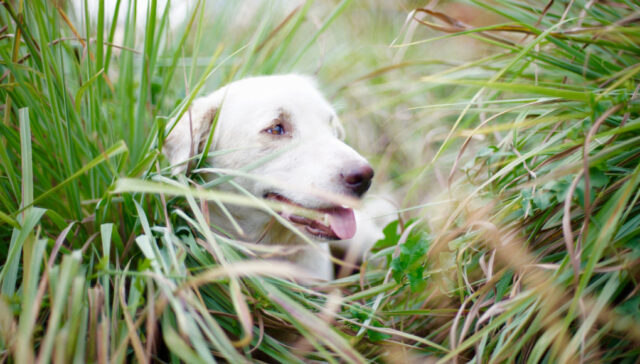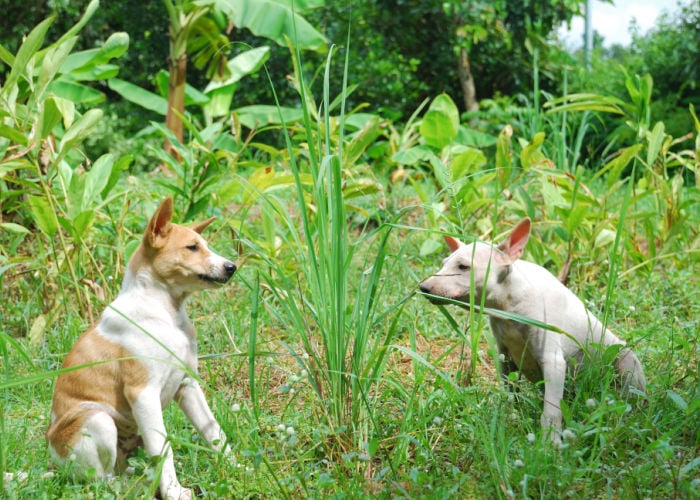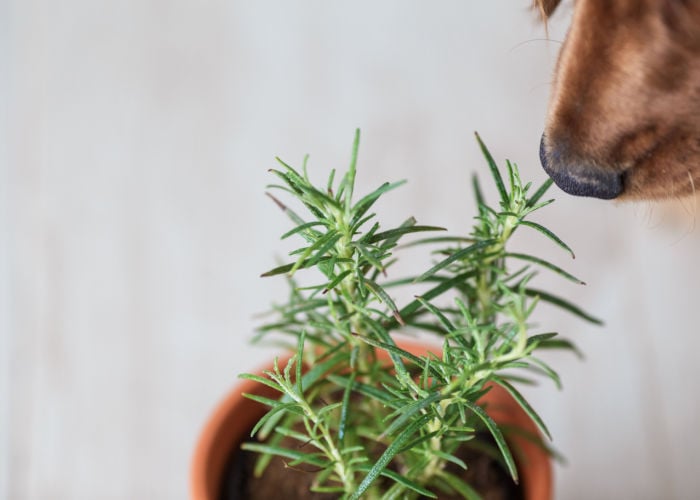
Table of Contents
Is lemongrass safe for dogs? How much is too much?
Did you catch your dog chomping your lemongrass?
Well, it’s pretty normal to wonder and be worried, especially when our furry pets suddenly ingest plants we’re not sure are safe.
There are even debates on the internet about what is toxic and what is not.
But what is the truth? Can dogs eat lemongrass?
We'll answer everything you need to know right here—from this plant’s components to its treatments in cases of poisoning.
Let’s begin, shall we?
What Is Lemongrass?
Lemongrass is a tropical perennial plant native to the tropics. The term “lemongrass” comes from the essential oil in the shoot, which has an aromatic lemon-like odor.
It is a crucial culinary herb in tropical Asia, particularly Thailand, Cambodia, Indonesia, Malaysia, and India.
But this plant does more than give your food a fresh, aromatic flavor. It also provides an array of health benefits.
According to research, it is a powerful antibacterial and antifungal agent. It also lowers blood sugar and cholesterol levels and has historically been used to treat pain.
In addition, lemongrass essential oil is used in aromatherapy to improve mood, freshen the air, and lessen stress.
Did you know you can use it to ward off mosquitoes as well?
Although lemongrass has a soothing scent to us, it actually repels the pesky biting insects.
You can enjoy being outside without worrying about getting bitten if you have a few of these plants in your garden.
But the question is…

Can Dogs Eat Lemongrass?
I’ve grown them in my yard. I wonder if lemongrass is toxic to my dog.
Perhaps you’ve become aware of the benefits and think getting rid of your plants would waste everything you've invested in growing them.
Or maybe you're just curious and careful about what you shouldn't feed your dog.
To answer your question, using lemongrass plants in environments where dogs have free access is safe.
There's no need for concern if they rarely get into the yard and nibble a few pieces.
However, remember that only small quantities are safe for our dogs.
If your dog doesn't have chewing issues, meaning it doesn't wander around ingesting anything it finds, you don't need to waste your time by taking your plant out of the garden.
Although, it’s a different story when our four-legged friends consume it in excess amounts.
Is Lemongrass Poisonous to Dogs?
The rare harmless incident where Fido consumes lemongrass is possible. The risk comes from intending to feed them with it.
The digestive system of our dogs has no capacity for processing plenty of plant matter.
Therefore, too much lemongrass consumption by dogs might result in a dangerous intestinal blockage.
The worst-case scenario is death or other problems, including paralysis.
According to ASPCA, what makes lemongrass toxic to dogs is its natural toxin called cyanogenic glycosides.
When your furry pet eats this toxin, its digestive system converts cyanogenic glycosides into cyanide.
When this happens, the blood's oxygen cannot be transferred to the cells as easily.
Be cautious that a sufficient amount of cyanide can be deadly in less than an hour.
In light of this, keeping an eye on your dog outside is safer, and you should keep your lemongrass plants out of its reach.
Pro tip: Other plants besides lemongrass may produce cyanogenic glycosides, such as legumes, pome fruits, and peaches.
Is Lemongrass Essential Oil Safe for Dogs?
Lemongrass essential oil is typically safe for dogs.
The oil is generally harmless as long as it's diluted and applied in a manner that prevents your dog from ingesting it.
For context, you can diffuse it in an open space where air can flow through effectively.
Not that you ought to use it on yourself, especially when your dog has a habit of licking you.
Giving your dog lemongrass oil to lick or swallow could be detrimental to its health. They can develop skin irritation, gastrointestinal distress, and even liver damage.
Additionally, it's dangerous, especially if your dog is diabetic or taking medication for high blood pressure.
But would it be alright to apply it to my dog?
We must say no.
Although others recommend applying lemongrass oil to your dog due to its insect-repellent properties, we don't encourage it.
Lemongrass oil has a high citral content, which could burn your dog's skin. It is risky unless you’re using a product specifically for pets or have your vet’s supervision.
How about products that use lemongrass oil?
Yes. The safety of our pets is an important factor in manufacturing most of these products.
Because of how popular its citrus-like scent is with consumers, no wonder it's also present in various dog shampoos and sprays.
They frequently come with instructions for safe use when applying these products to your dog.
The products remain safe if you can properly follow these instructions or use the dosage given.

Signs & Symptoms of Lemongrass Poisoning
If Fido eats large amounts of lemongrass, watch for the following symptoms of lemongrass poisoning.
Contact your vet if you notice your pet showing any of these.
Gastrointestinal Issues
As mentioned, plenty of plants are too difficult for our dogs' digestive systems to process.
Lemongrass can cause digestive issues in dogs if they consume it in large quantities. Symptoms may include nausea, diarrhea, hypersalivation, and abdominal pain.
Fido may also suffer from bloating.
It happens from the accumulation of the plant your dog ingested due to less active muscles that move food through the digestive system.
Dehydration
The most frequent side effect of pet food poisoning is excessive thirst.
Their body loses fluids and electrolytes when they vomit or have diarrhea due to food poisoning.
Whether eating plants is not a recurring problem in your dog, we encourage you to leave water bowls around your home.
Try putting them in different spots (even outdoors), but check on them from time to time to ensure they're still full and fresh.
Fever
Your dog can experience a fever within 24 hours of consuming excessive amounts of lemongrass.
Applying cool water to your dog's paws and ears will help lower its temperature. Use a wet towel or a dog-cooling vest.
If possible, encourage them to drink small amounts of water on a daily basis in order to stay hydrated, but don't force it.
Continue to keep an eye on its temperature. Next, call your vet.
Breathing problems
Dogs suffering from severe lemongrass poisoning may experience brain hypoxia.
Remember about the cyanogenic glycosides?
When your dog consumes lemongrass, it also consumes this toxin, which interferes with cellular respiration.
Salivation, fast or difficult breathing, and even convulsions and paralysis are symptoms of cyanide toxicity.
You’ll notice your dog’s bright cherry red gums, indicating that the oxygen in the blood cannot be delivered to the cells, resulting in suffocation.
Important: Cyanide toxicity is a medical emergency. As you take your dog to the hospital, call your vet so that they can have materials ready to begin treatment.
Diagnosis of Lemongrass Poisoning
It's vital to provide your vet with as much information as possible about how much lemongrass your dog has consumed.
The same holds true for a different plant you saw that you're unsure is safe. If you are unsure of its type, bring over a photo of the plant.
When you arrive at the vet's clinic, they will perform a physical checkup to check your pet's vitals and any abnormalities.
The vet will run blood tests to see how Fido's internal organs are working.
They’ll perform a complete blood count (CBC) to evaluate whether toxins remain in your dog's system.
In addition, the doctor may want to conduct a radiograph of your dog's belly to look for any abnormalities or blockages that are causing the vomiting.
Is Lemongrass Safe for Dogs: Treating Lemongrass Poisoning
With prompt treatment, most dogs with plant poisoning will recover completely, especially if they only consumed a tiny amount.
However, you should contact your vet if your furry friend develops serious symptoms.
They may administer any of the following for emergency treatment:
Intravenous Fluids
Because your dog may get dehydrated due to vomiting and diarrhea, IV infusion allows your vet to deliver fluids directly into your dog's bloodstream.
It also quickly and safely eliminates the toxic substance from your dog's system.
More importantly, it helps to keep Fido's blood pressure stable so that oxygen can continue to flow through the body and reach its vital organs.
Activated Charcoal
Following toxin ingestion, activated charcoal is a gastrointestinal decontaminant for your four-legged companion.
It is widely prescribed by vets as an emergency treatment for dogs.
It is available as a tablet, capsule, or thick, black liquid. They can make it in the vet clinic by mixing the activated charcoal powder with water.
It is done directly into your dog's stomach through a tube.
Once the toxin binds to the charcoal, your furry child will expel it through his feces.
Note: Depending on the kind of poison and your dog's symptoms, your vet will decide whether or not to prescribe activated charcoal.
Induced Vomiting
Inducing vomiting in your pawed pet, like activated charcoal, is an emergency remedy to eliminate toxins from its gastrointestinal tract.
If your vet advises you to induce vomiting, you are most likely to deliver an exact dose of hydrogen peroxide orally.
Syringes may be helpful in providing the solution through your dog's mouth. The dosage differs based on the type of dog and the current situation.
Treatment is usually only effective within 2 hours of intake. Make sure to follow up with your vet.
Warning: Inducing vomiting is not always the best method to treat toxins. There are severe effects, such as the toxic substance passing through a second time.

Why Does My Dog Eat My Lemongrass?
It's hardly the most unusual thing in the world to have a doggo who enjoys eating lemongrass plants (or plants in general).
According to Dr Stephanie Austin, this happens due to their natural tendency to graze, curiosity, or accidentally ingesting plant parts while playing with them.
Another possibility is that your pawed pet is simply bored. Perhaps you didn't offer engaging interactions, so they looked for diversions.
Unfortunately, they may eat your plants to occupy themselves.
We cannot emphasize enough the importance of giving them safe dog toys and scheduling their playing and exercise where you can watch them.
Maintaining your furry friend's mental stimulation would help to alleviate its ennui.
Also, it stops the dog from ingesting harmful substances and engaging in destructive activity.
Remember that busy dogs are less likely to nibble on things they shouldn't.
Another reason is that they simply like the taste and texture of the grass in their mouths.
In fact, many doggos are grass aficionados who favor eating the freshest springtime grass.
No matter why your dog consumes plants, you should also be concerned about the herbicides and pesticides sprayed on them.
What Other Herbs Are Bad for My Dog?
Should I only be worried about lemongrass? What about herbs?
We know you love your pawed child as much as you love your garden.
However, there might be specific herbs there that you don't want your Fido to become interested in and eventually ingest.
What exactly are these?
Bay Leaf
Eugenol and other essential oils in bay leaves make them hazardous to dogs. It causes gastrointestinal problems like diarrhea and vomiting.
Moreover, this herb has sharp edges.
It runs the risk of choking if your animal companion consumes one by accident. It can even tear its throat and digestive tract.
Hops
They can be extremely dangerous to your dog and cause a life-threatening rise in body temperature.
Even a study’s result of hops ingestion caused hyperthermia in 96% of dogs (68/71).
Our dogs’ normal temperature ranges between 101 and 102.5 degrees Fahrenheit.
When they consume hops, their body temperature rises above 102.5 degrees, which is harmful.
Oregano
Oregano is actually safe, and your pawed pal can enjoy its amazing health benefits.
But, like with other things, too much of a good thing may be harmful.
If eaten excessively, your furry child can develop blood clotting disorders and lessen glucose levels. So be sure that your dog’s consuming this herb moderately.
Spanish Thyme
Spanish thyme contains diterpene along with other toxic oils. Excessive eating of this can cause Fido to have difficulty breathing and bloody diarrhea.
Other typical symptoms include anorexia, depression, excessive drinking, and urinating.

Is Lemongrass Safe for Dogs: FAQs
Is it okay for dogs to smell lemongrass?
It is absolutely pet-safe. Make sure you diffuse the essential oil in a well-ventilated room since it can be overwhelming for your dog.
Diffusing citronella or lemongrass oil outside may also repel insects, keeping mosquitoes and fleas at bay.
What essential oils are safe for dogs?
Natural scents that are non-toxic to dogs include:
- Myrrh
- Ginger
- Rosemary
- Chamomile
- Peppermint
- Lavender oil
These aid in calming and relaxation and might make your dog feel safe in a strange or new environment.
Does lemongrass deter dogs from peeing?
A scent that dogs probably hate is citrus-based. So bergamot, citronella, and lemongrass may keep these dogs away from an area.
These scents can be used in scented candles to deter your dog from going to spots where you don't want it to urinate.
Is Lemongrass Safe for Dogs: Parting Thoughts
After all, lemongrass and dogs don't make a horrific pair when you take precautions and know how to look out for your pawed friend.
Now that you learned that lemongrass is safe for dogs, removing them from your yard is unnecessary. As long as your dog’s not gnawing on them, then it should be safe.
However, if eating it has been a recurring issue, it’s best to block them from getting to your plants and engage them in an activity to be occupied.
When your dog exhibits symptoms, contact the vet right away so that they can offer emergency treatment.
To know about toxic and safe plants for your furry child, read the next articles for more information.












